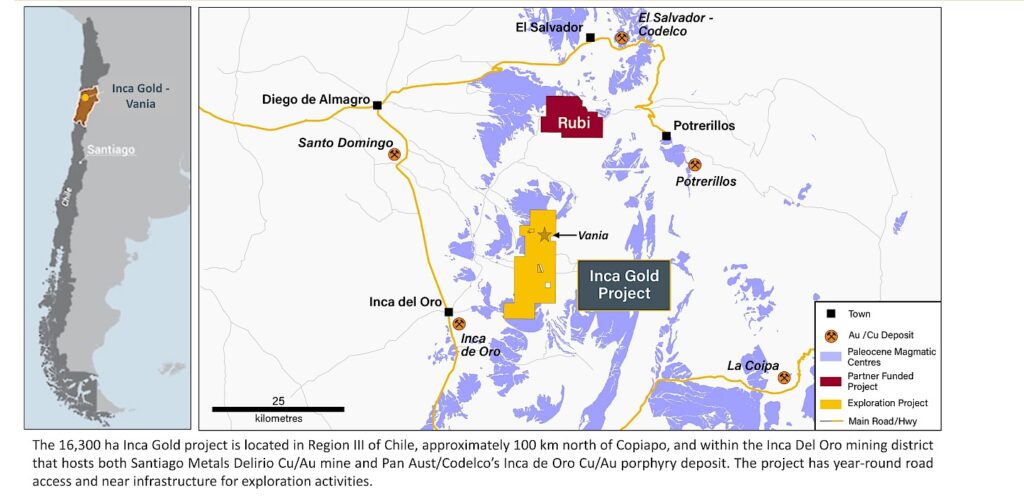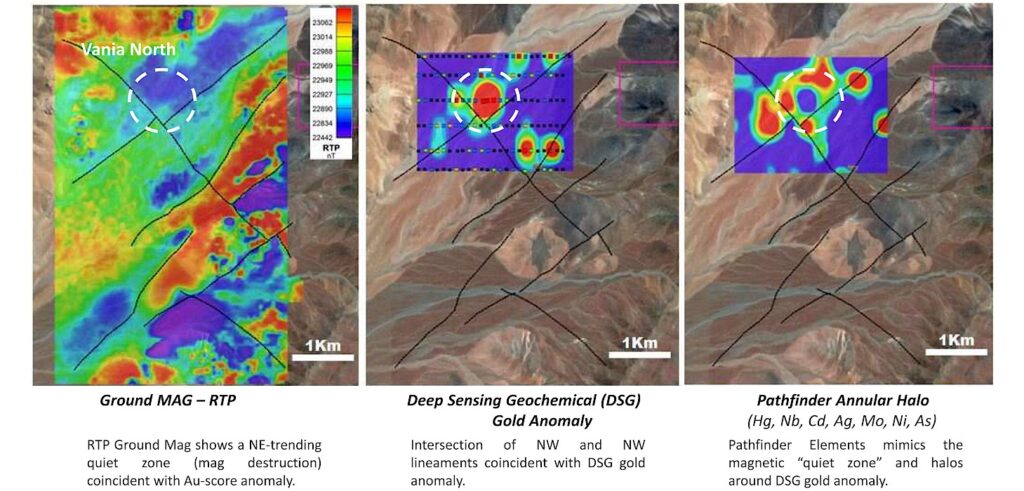Mirasol Resources Ltd. announced to report the identification of a compelling drill target at Vania North prospect on the Inca Gold Project (“Inca Gold”) in Chile. Mirasol has also mobilized an Induced Polarity (IP) Survey crew to survey a second potential drill target at Vania South. Inca Gold is a large 16,300-hectare property package, with multiple exploration prospects, that has been optioned from Newmont Corporation (“Newmont”). Mirasol has the option to earn-in 100% of Inca Gold, subject to a 1.5% NSR royalty
“Two concealed zones at Vania are advancing as drill targets with coincident geochemical and geophysical anomalies that have been strengthened with recent IP at Vania North”, Mirasol’s President, Tim Heenan, commented. “The Vania North and Vania South zones are controlled along a structural corridor within a well-endowed district that hosts significant advanced projects and producing mines.”
The Vania prospect (“Vania”) hosts two separate Porphyry/IOCG and/or High-Sulfidation Epithermal (HSE) targets concealed under transported alluvial/colluvial cover in a very attractive structural architectural setting. Vania is set within a strong north-northeast structural corridor which hosts the Inca del Oro porphyry to the south and the expansive El Salvador mining district to the north.
Figure 1: Location of Inca Gold Project and the Vania Prospects

Vania North:
The area is characterized by several distinct, coincident geochemical and geophysical anomalies cradled within an attractive structural intersection. A recent Electrical IP Pole-Dipole survey over the anomalies has successfully detected compelling coincident IP anomalies. Vania North is considered a high-quality drill target.
A strong coherent geochemical gold anomaly was originally identified using Newmont`s proprietary Deep Sensing Geochemical (DSG) sampling system. The DGS system detects concealed anomalies under transported material by using a highly technical and effective sampling and analysis procedure, in conjunction with detailed regolith mapping. Coincident with the DGS gold anomaly is a strong annular geochemical halo of pathfinder elements (Hg, Nb, Cd, Ag, Mo, Ni, As) within magnetic depletion zone interpreted to be controlled by the intersection of NW and NE trending structural lineaments.
Mirasol’s subsequent reprocessing and reinterpretation of the Newmont magnetic data clearly delineates a prominent NE-SW trend of magnetic depletion, coincident within a long, shallow topographic valley. The magnetic depletion and low resistivity, identified from the recent IP survey, suggests that the rocks along this trend may have been subjected to acid-sulphate leaching and may contain sections of vuggy silica, which are deemed to be prospective zones for late-stage mineralizing events.
On the western edge of the concealed anomaly, within the outcropping wall rocks at the edge of cover, alteration is seen in the form of locally hornfelsed rocks hosting Cu mineralization in small structures.
Figure 2: Vania North Target – Coincident Ground MAG, Geochemical and Pathfinder Anomaly

The recent electrical IP geophysical campaign has highlighted several compelling concealed targets at Vania North. The geophysical interpretation suggests the potential existence of HSE-type anomalies, which may represent diatreme and vein-type structures, possibly underlain by a deeper more “porphyry-like” geophysical response, which warrants further evaluation, including drilling. Prior to drilling, which is scheduled to commence in Q4 2022, Mirasol will complete infill DSG lines at Vania North to vector into the best areas for the maiden drill program.
Figure 3: Vania North Target – Potential Geophysical Targets Generated from Electrical IP Survey

Vania South:
The reprocessing and interpretation of the magnetic data has resulted in the identification of a second compelling prospect three kilometers south of Vania North. At the Vania South target a very discrete and strong concealed magnetic source exists within the SE corner of the Mag grid, showing smooth magnetic textures surrounding the main anomaly. Interpretation of the magnetic data suggests that this may be a very strong magnetic anomaly that could represent a concealed porphyry target, with the magnetic source potentially characterizing the potassic-altered core of an intrusive body and the smooth magnetic border representing the envelope of hydrothermal alteration.
Figure 4: Vania South Prospect – Reprocessed MAG Data Identifies Compelling New Prospect

In both the northern and southern areas of the concealed anomaly and outcropping within the exposed rocks at the edge of cover, strong alteration exists in the form of local silicification and pervasive clay alteration as might be expected at the upper levels above and flanking a porphyry copper system. Strong mineralization exists in the surrounding rocks at Vania South and characterized by quartz-tourmaline veinlets with specular hematite and local copper oxide colours. Geochemical results from the recent prospecting campaign are pending. This alteration and mineralization could be peripheral and distal to the concealed magnetic anomaly, which would indicate a potential concealed porphyry/IOCG target.
Mirasol has mobilized a crew to conduct an electrical IP Pole-Dipole survey over the magnetic body to detect further geophysical features which may identify additional quality drill targets at the Vania South prospect. As at Vania North, Mirasol will also complete new DSG lines at Vania South to test for geochemical anomalies within the surface regolith cover.
(Source: Press Releases – www.mirasolresources.com/news/mirasol-identifies-new-drill-targets-on-the-inca-copper-gold-project-in-chile-drilling-planned-for-fourth-quarter-2022/)
Please send your press releases to press@miningnewspaper.com or juan.lamadrid@miningnewspaper.com